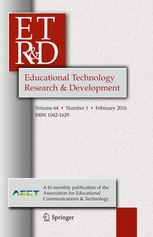The design of motivational agents and avatars
While the addition of an anthropomorphic interface agent to a learning system generally has little direct impact on learning, it potentially has a huge impact on learner motivation. As such agents become increasingly ubiquitous on the Internet, in virtual worlds, and as interfaces for learning and gaming systems, it is important to design them to optimally impact motivation. The focus of this paper is on the design of agents and avatars (one’s self-representation as a visual agent) for enhancing motivational and affective outcomes, such as improving self-efficacy, engagement and satisfaction, moderating frustration, and/or improving stereotypes. Together with motivational messages and dialogue (which are not discussed here), the agent’s appearance is the most important design feature as it dictates the learner’s perception of the agent as a virtual social model, in the Bandurian sense. The message delivery, through a human-like voice with appropriate and relevant emotional expressions, is also a key motivational design feature. More research is needed to determine the specifics with respect to the ideal agent voice and the role of other nonverbal communication (e.g., deictic gestures) that may contribute to the agent’s role as an embodied motivator, particularly in the long-term.

